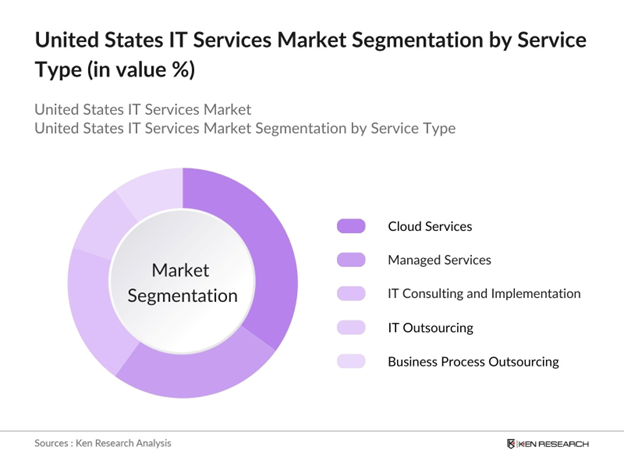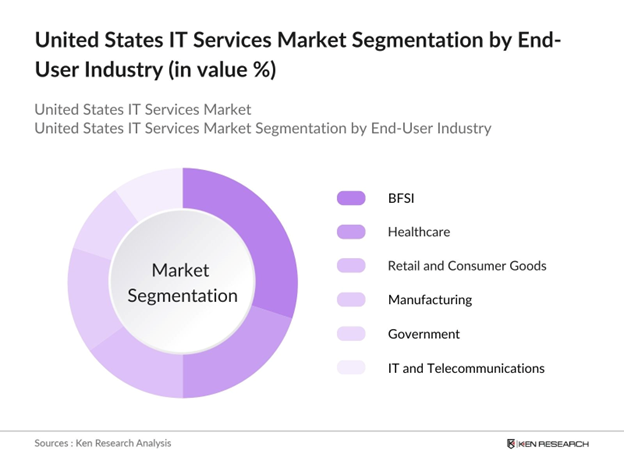
United States IT Services Market Outlook to 2030
Region:North America
Author(s):Sanjna
Product Code:KROD11114
December 2024
95
About the Report
United States IT Services Market Overview
- The United States IT services market is a dynamic and rapidly evolving sector, valued at USD 403 billion. This substantial market size is driven by the widespread adoption of digital transformation initiatives across various industries, the increasing reliance on cloud computing solutions, and the growing emphasis on cybersecurity measures. Organizations are investing heavily in IT services to enhance operational efficiency, improve customer experiences, and maintain a competitive edge in the digital era.

- Major metropolitan areas such as New York City, San Francisco, and Seattle dominate the U.S. IT services market. These cities are home to a high concentration of technology companies, a skilled workforce, and robust infrastructure, making them hubs for innovation and IT service delivery. The presence of leading tech firms and startups fosters a competitive environment that drives the demand for advanced IT services.
- The U.S. enforces stringent data protection laws to safeguard personal information. The California Consumer Privacy Act (CCPA) grants residents rights over their personal data, affecting businesses nationwide. The Federal Trade Commission (FTC) enforces data protection regulations, with fines totaling over $1 billion in 2022 for privacy violations. Compliance with such regulations necessitates robust IT services to ensure data security and privacy.
United States IT Services Market Segmentation
By Service Type: The U.S. IT services market is segmented by service type into IT consulting and implementation, IT outsourcing, business process outsourcing, managed services, and cloud services. Among these, cloud services hold a dominant market share. This dominance is attributed to the increasing adoption of cloud computing solutions by businesses seeking scalability, cost-efficiency, and flexibility in their operations. The shift towards remote work and the need for robust data storage and processing capabilities have further propelled the demand for cloud services.

By End-User Industry: The market is also segmented by end-user industry, including banking, financial services, and insurance (BFSI), healthcare, retail and consumer goods, manufacturing, government, and IT and telecommunications. The BFSI sector commands a significant market share due to its continuous investment in IT services to enhance security, improve customer service, and comply with regulatory requirements. The sector's focus on digital banking solutions and fintech innovations has further increased its reliance on IT services.

United States IT Services Market Competitive Landscape
The U.S. IT services market is characterized by the presence of several key players who drive innovation and set industry standards. These companies leverage their extensive experience, technological expertise, and comprehensive service portfolios to maintain a competitive edge.

United States IT Services Market Analysis
Growth Drivers
- Digital Transformation Initiatives: In 2024, U.S. businesses are investing heavily in digital transformation to enhance operational efficiency and customer engagement. The U.S. Department of Commerce reported that e-commerce sales reached $1.03 trillion in 2022, indicating a significant shift towards digital platforms. This trend is driving demand for IT services to support online operations and digital customer interactions. Additionally, the U.S. Bureau of Economic Analysis noted that information technology investments contributed $1.5 trillion to the GDP in 2023, underscoring the critical role of digital transformation in economic growth.
- Adoption of Cloud Computing: The adoption of cloud computing in the U.S. has accelerated, with the National Institute of Standards and Technology (NIST) reporting that over 90% of enterprises utilize cloud services as of 2023. This widespread adoption is driven by the need for scalable and flexible IT solutions. The U.S. Census Bureau highlighted that cloud-based services have become integral to business operations, facilitating remote work and data management. The Federal Risk and Authorization Management Program (FedRAMP) has authorized over 200 cloud service providers, ensuring secure cloud solutions for federal agencies and boosting confidence in cloud adoption across sectors.
- Emphasis on Cybersecurity: With the rise in cyber threats, U.S. organizations are prioritizing cybersecurity measures. The Federal Bureau of Investigation's Internet Crime Complaint Center (IC3) received 847,376 complaints in 2022, with reported losses exceeding $10.3 billion. In response, the Cybersecurity and Infrastructure Security Agency (CISA) launched initiatives to enhance national cybersecurity resilience, including the Cybersecurity Workforce Training Guide to develop skilled professionals.
Challenges
- Data Security and Privacy Concerns: Data breaches remain a significant challenge in the U.S. The Identity Theft Resource Center reported 1,862 data breaches in 2021, exposing over 293 million records. The Federal Trade Commission (FTC) enforces data protection regulations, with fines totaling over $1 billion in 2022 for privacy violations. The California Consumer Privacy Act (CCPA) imposes strict data privacy requirements, affecting businesses nationwide. Compliance with such regulations necessitates robust IT services to ensure data security and privacy.
- High Implementation Costs: Implementing advanced IT solutions involves substantial costs. The U.S. Small Business Administration notes that small businesses often face financial constraints, with 29% citing lack of capital as a primary challenge. The National Association of Manufacturers reported that 63% of manufacturers identified high costs as a barrier to technology adoption in 2023. These financial challenges can hinder the adoption of necessary IT services, particularly among small and medium-sized enterprises.
United States IT Services Market Future Outlook
Over the next five years, the United States IT services market is expected to experience significant growth. This expansion will be driven by continuous advancements in technology, increasing adoption of artificial intelligence and machine learning, and the growing importance of data analytics. Organizations across various sectors are anticipated to invest more in IT services to enhance operational efficiency, improve customer engagement, and gain a competitive advantage in the digital landscape.
Market Opportunities
- Expansion of IoT Applications: The Internet of Things (IoT) is expanding across U.S. industries. The Federal Communications Commission (FCC) reported over 50 billion connected devices in 2023, enhancing operational efficiency in sectors like manufacturing and healthcare. The Department of Transportation's Smart City Challenge awarded $40 million to Columbus, Ohio, in 2016 to implement IoT solutions for urban mobility, setting a precedent for other cities. The National Institute of Standards and Technology (NIST) provides guidelines for IoT cybersecurity, promoting secure adoption of IoT technologies.
- Growth in Remote Work Solutions: The COVID-19 pandemic accelerated the adoption of remote work in the U.S. The U.S. Census Bureau reported that 27.6 million people worked primarily from home in 2021. The Department of Labor's Occupational Safety and Health Administration (OSHA) provides guidelines for home office safety, supporting the remote workforce. The General Services Administration (GSA) offers telework resources for federal employees, promoting flexible work arrangements. This shift creates opportunities for IT services to support secure and efficient remote work solutions.
Scope of the Report
|
Segment |
Sub-Segments |
|
By Service Type |
IT Consulting and Implementation |
|
By Organization Size |
Small and Medium Enterprises (SMEs) |
|
By End-User Industry |
Banking, Financial Services, and Insurance (BFSI) |
|
By Deployment Model |
On-Premises |
|
By Region |
Northeast |
Products
Key Target Audience
IT Service Providers
Cloud Service Providers
Managed Service Providers
Cybersecurity Firms
Financial Institutions (e.g., Banks, Insurance Companies)
Healthcare Organizations
Government and Regulatory Bodies (e.g., Federal Trade Commission)
Investors and Venture Capitalist Firms
Companies
Players Mentioned in the Report
IBM Corporation
Microsoft Corporation
Accenture PLC
Tata Consultancy Services Ltd.
Wipro Limited
Infosys Limited
Capgemini SE
HCL Technologies
Cognizant Technology Solutions Corp
Oracle Corporation
Table of Contents
1. United States IT Services Market Overview
1.1 Definition and Scope
1.2 Market Taxonomy
1.3 Market Growth Rate
1.4 Market Segmentation Overview
2. United States IT Services Market Size (In USD Million)
2.1 Historical Market Size
2.2 Year-On-Year Growth Analysis
2.3 Key Market Developments and Milestones
3. United States IT Services Market Analysis
3.1 Growth Drivers
3.1.1 Digital Transformation Initiatives
3.1.2 Adoption of Cloud Computing
3.1.3 Emphasis on Cybersecurity
3.1.4 Integration of Artificial Intelligence and Machine Learning
3.2 Market Challenges
3.2.1 Data Security and Privacy Concerns
3.2.2 High Implementation Costs
3.2.3 Shortage of Skilled IT Professionals
3.3 Opportunities
3.3.1 Expansion of IoT Applications
3.3.2 Growth in Remote Work Solutions
3.3.3 Increasing Demand for Managed Services
3.4 Trends
3.4.1 Shift Towards Hybrid Cloud Environments
3.4.2 Rise of Edge Computing
3.4.3 Emphasis on IT Service Automation
3.5 Government Regulations
3.5.1 Data Protection Laws
3.5.2 Compliance Standards (e.g., GDPR, CCPA)
3.5.3 Federal IT Modernization Initiatives
3.6 SWOT Analysis
3.7 Stakeholder Ecosystem
3.8 Porters Five Forces Analysis
3.9 Competitive Landscape
4. United States IT Services Market Segmentation
4.1 By Service Type (In Value %)
4.1.1 IT Consulting and Implementation
4.1.2 IT Outsourcing
4.1.3 Business Process Outsourcing
4.1.4 Managed Services
4.1.5 Cloud Services
4.2 By Organization Size (In Value %)
4.2.1 Small and Medium Enterprises (SMEs)
4.2.2 Large Enterprises
4.3 By End-User Industry (In Value %)
4.3.1 Banking, Financial Services, and Insurance (BFSI)
4.3.2 Healthcare
4.3.3 Retail and Consumer Goods
4.3.4 Manufacturing
4.3.5 Government
4.3.6 IT and Telecommunications
4.4 By Deployment Model (In Value %)
4.4.1 On-Premises
4.4.2 Cloud-Based
4.4.3 Hybrid
4.5 By Region (In Value %)
4.5.1 Northeast
4.5.2 Midwest
4.5.3 South
4.5.4 West
5. United States IT Services Market Competitive Analysis
5.1 Detailed Profiles of Major Companies
5.1.1 IBM Corporation
5.1.2 Microsoft Corporation
5.1.3 Accenture PLC
5.1.4 Tata Consultancy Services Limited
5.1.5 Wipro Limited
5.1.6 Infosys Limited
5.1.7 Capgemini SE
5.1.8 HCL Technologies
5.1.9 Cognizant Technology Solutions Corp
5.1.10 Oracle Corporation
5.2 Cross Comparison Parameters (Revenue, Number of Employees, Service Portfolio, Market Presence, Client Base, Innovation Initiatives, Strategic Partnerships, Regional Coverage)
5.3 Market Share Analysis
5.4 Strategic Initiatives
5.5 Mergers and Acquisitions
5.6 Investment Analysis
5.6.1 Venture Capital Funding
5.6.2 Government Grants
5.6.3 Private Equity Investments
6. United States IT Services Market Regulatory Framework
6.1 Data Protection and Privacy Regulations
6.2 Compliance Requirements
6.3 Certification Processes
7. United States IT Services Future Market Size (In USD Million)
7.1 Future Market Size Projections
7.2 Key Factors Driving Future Market Growth
8. United States IT Services Future Market Segmentation
8.1 By Service Type (In Value %)
8.2 By Organization Size (In Value %)
8.3 By End-User Industry (In Value %)
8.4 By Deployment Model (In Value %)
8.5 By Region (In Value %)
9. United States IT Services Market Analysts Recommendations
9.1 Total Addressable Market (TAM), Serviceable Available Market (SAM), and Serviceable Obtainable Market (SOM) Analysis
9.2 Customer Cohort Analysis
9.3 Marketing Initiatives
9.4 White Space Opportunity Analysis
Research Methodology
Step 1: Identification of Key Variables
The initial phase involves constructing an ecosystem map encompassing all major stakeholders within the United States IT Services Market. This step is underpinned by extensive desk research, utilizing a combination of secondary and proprietary databases to gather comprehensive industry-level information. The primary objective is to identify and define the critical variables that influence market dynamics.
Step 2: Market Analysis and Construction
In this phase, we compile and analyze historical data pertaining to the United States IT Services Market. This includes assessing market penetration, the ratio of service providers to end-users, and the resultant revenue generation. Furthermore, an evaluation of service quality statistics is conducted to ensure the reliability and accuracy of the revenue estimates.
Step 3: Hypothesis Validation and Expert Consultation
Market hypotheses are developed and subsequently validated through computer-assisted telephone interviews (CATIs) with industry experts representing a diverse array of companies. These consultations provide valuable operational and financial insights directly from industry practitioners, which are instrumental in refining and corroborating the market data.
Step 4: Research Synthesis and Final Output
The final phase involves direct engagement with multiple IT service providers to acquire detailed insights into service segments, sales performance, client preferences, and other pertinent factors. This interaction serves to verify and complement the statistics derived from the bottom-up approach, thereby ensuring a comprehensive, accurate, and validated analysis of the United States IT Services market.
Frequently Asked Questions
01. How big is the United States IT Services Market?
The United States IT services market was valued at USD 403 billion, driven by the increasing adoption of digital transformation initiatives and the growing reliance on cloud computing solutions.
02. What are the challenges in the United States IT Services Market?
Challenges in the U.S. IT services market include data security and privacy concerns, high implementation costs, and a shortage of skilled IT professionals. These factors can hinder the seamless adoption and integration of IT services across organizations.
03. Who are the major players in the United States IT Services Market?
Key players in U.S. IT services market include IBM Corporation, Microsoft Corporation, Accenture PLC, Tata Consultancy Services Ltd., and Wipro Limited. These companies dominate due to their extensive service portfolios, technological expertise, and strong market presence.
04. What are the growth drivers of the United States IT Services Market?
U.S. IT services market is propelled by factors such as digital transformation initiatives, adoption of cloud computing, emphasis on cybersecurity, and the integration of advanced technologies like artificial intelligence and machine learning.
Why Buy From Us?

What makes us stand out is that our consultants follows Robust, Refine and Result (RRR) methodology. i.e. Robust for clear definitions, approaches and sanity checking, Refine for differentiating respondents facts and opinions and Result for presenting data with story

We have set a benchmark in the industry by offering our clients with syndicated and customized market research reports featuring coverage of entire market as well as meticulous research and analyst insights.

While we don't replace traditional research, we flip the method upside down. Our dual approach of Top Bottom & Bottom Top ensures quality deliverable by not just verifying company fundamentals but also looking at the sector and macroeconomic factors.

With one step in the future, our research team constantly tries to show you the bigger picture. We help with some of the tough questions you may encounter along the way: How is the industry positioned? Best marketing channel? KPI's of competitors? By aligning every element, we help maximize success.

Our report gives you instant access to the answers and sources that other companies might choose to hide. We elaborate each steps of research methodology we have used and showcase you the sample size to earn your trust.

If you need any support, we are here! We pride ourselves on universe strength, data quality, and quick, friendly, and professional service.















